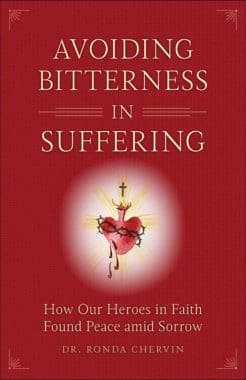Jesus healed many sufferers of physical illness and pain (Matt. 4:23) such as the man born blind, the lepers, Peter’s mother-in-law, and the woman with the flow of blood. Some Christians conclude that the only way to meet the Lord in disability and pain is by praying for healing.
Everyone who is afflicted with physical handicaps, sickness, or fatigue should pray to Jesus for healing. However, since so many holy people pray for healing without any change in their bodily state of infirmity, it seems clear that Jesus does not choose to heal in every case. Sometimes our pain is allowed by him for the sake of our own sanctification or to be offered for the sins of the world.
This chapter will concentrate on meeting Christ in bodily pain of an acute variety, but there will also be references to saints who suffered from chronic ailments and from long periods of tiredness or the mental fatigue that comes from overwork.
Lydwine of Schiedam: A Saint for the Afflicted
The story given here of St. Lydwine of Schiedam is based on a book by J. K. Huysmans. Huysmans’s account of the life of this saint is as accurate as it is extraordinary, based on information from a relative of St. Lydwine who lived in her house for years, as well as from the writings of Lydwine’s last confessor, eyewitness accounts of those who knew her, and official documents from the Burgomasters of Schiedam.
Lydwine, a saint of Holland, lived between the years 1380 and 1433. She was a contemporary of Joan of Arc, of the same historical era of ferocious battles between royal families. Other horrors were decimating plagues and the conflicts between the antipopes.
Lydwine would offer her phenomenal sufferings in expiation for the sins of people she knew from her town, for the souls in purgatory, for the abominations of schism, and for the excesses of clerics, monks, kings, and common people. She was lovingly supported by brothers living under the rule of St. Augustine who were founding numerous monasteries in Holland to overcome the evils of the times.
Lydwine was born in Schiedam near the Hague. She was the fourth child and only daughter of a family that had eight sons. Lydwine wanted to live for God alone. As in so many other stories of saints, Lydwine’s parents stood against her vocation. They wanted her to marry. Since the girl was so beautiful and sweet, it seemed as if she would have no trouble fulfilling the dreams of her mother and father for a good marriage.
In an effort to evade their wishes, Lydwine begged God to make her ugly. At fifteen she contracted an illness that left her thin, hollow faced, and greenish in color. The green turned to ash gray as she began to recover. She was so weak, she could not leave her room.
You might think that our young saint was kind of neurotic or morbid, but this was not really so. Lydwine had a merry temperament and loved to be outside with her friends. She especially enjoyed ice skating. So, even though she was not completely well yet, she followed her desire and set out for the pond to skate. Unfortunately, or providentially, depending on your point of view, the poor girl was dashed against the ice, breaking a rib in the process.
The break led to a tumor and then to agonizing pain. Strangely, none of the usual medical remedies helped. After quite a time of trying different doctors, the most famous expert visited Lydwine. To everyone’s astonishment, he examined her and proclaimed that her illnesses were from God for the sake of expiating the sins of the world. Because of their supernatural origin, no medical procedures could help her.
Now follows the descriptions of the pain of this Dutch saint, truly unbelievable in their severity. She could neither lie nor sit nor stand, so great was the pain in any of these positions. Lydwine vomited often,
“dragging herself on her knees, rolling on her stomach . . .
burning with fever . . . for three years. . . . To perfect her
martyrdom she was abandoned by those who until then
had come from time to time to visit her. The sight of her
agony, her groans and cries, the horrible mask of her face,
drove her visitors away. . . . Her family helped her, her
father’s kindness never failed . . . but her mother . . . was
often harsh with her (since she was such an extra burden
in an already overtaxed family). . . .
The wound under her rib, which was never healed,
swelled up, and gangrene declared itself. . . . Worms moved
under the skin of the stomach and spread over three
ulcers. . . . They were large and black. . . . Two hundred
worms were drawn out after one remedy.
Later came violent neuralgic pains in the temples. . . .
Her right eye was extinguished, the other bled, violent
toothache and blood flowing from mouth, ears and nose
. . . gallstones, cancers all over, putrefaction of the marrow
and dropsy after the ulcers were healed.”
These calamities Lydwine endured for thirty-eight years without an instant’s respite. All these ills were characteristic of the plagues then rampant. Yet her wounds, which made her hideous, exuded an odor of perfume, something like cinnamon and spices!
Did Lydwine accept all this right away with saintly resignation? She wept and fought and almost fell into despair from envy of healthy people. She would cry when she heard the laughter of her friends at play in the streets. During the first four years, she thought she was damned. She had no consolations or insights into God’s plan for her. She thought God refused to hear her prayers and that her pain was worthless.
Help came in the form of the counsel of a priest. He told Lydwine that she was to suffer for souls as Jesus suffered. She should not think that she was suffering for her own sins but for those of others, in imitation of Jesus, who suffered even though being without sin. “And if these souls [such as Lydwine], capable like their Creator of being chastised for the crimes of which they are not guilty, would not exist, it would be with the universe as it would be with our country without the protection of the dykes. It would be engulfed by the tide of sins like Holland by the flow of the waves.”
If she would accept this role in the Church, then even though she would still suffer terribly, the pain would be counterbalanced by excessive joy. “Your vocation is clear; it consists in sacrificing yourself for others, in making reparation for faults you have not committed, in the practice of a sublime and truly divine charity. . . . Say to Jesus: ‘I wish to place myself of my own will upon your Cross, and I wish it to be you who drive in the nails.’ Then she would see Mary and the Saints rejoicing.”
To meet Christ in her pain, she should meditate often on the Cross. She should not think that Jesus suffered less because it was for a shorter amount of time, because having set aside his divinity Jesus experienced all the burden of all sin for all time.
In the course of many years of talking to other Catholics who are in physical pain, I have found that some readily accept the teaching the priest gave Lydwine, whereas others violently reject it. Those who are repulsed by the idea of victim-souls expiating for the sins of the world usually say that since Jesus already died for our sins, setting oneself up as an expiator is not only distorted but even blasphemous. Besides, since sinners have free will, given them by God, how can the sufferings of another change them? No matter how much grace is poured out on them, it appears that most of them continue on their evil way unchanged! If not even Jesus can change them, how could we do so by some sort of remote control of offering up our pain for them?
I myself used to fall in between the two groups: on the one hand, being happy to offer my occasional bouts of pain for sinners because it is better than thinking of it as useless agony; on the other, not really understanding how the spiritual exchange could work.
Last year, I heard an explanation that not only satisfied me but also explained the many passages in the lives of the saints about raining graces on others through self-offering. Christ honors our free will very highly. His general practice is to avoid overriding free will by overpowering graces. So touched is his heart, however, by the love of him and of neighbor manifested when someone is willing to endure agonizing pain in expiation that this love is allowed to tip the scale, sending overpowering graces of contrition to the sinner!
Whether you agree with this spiritual theology or not, I am sure you will be happy to hear that soon after the visit of the priest, at Easter, right after receiving Holy Communion, Lydwine’s soul was overwhelmed by love. She saw within herself the face of Christ in his Passion.
How to Meet Christ in Pain and Fatigue
- We should always begin by praying for healing in the case of illness and pain and for relief in the case of exhausting labors.
- We should not be alarmed if we reject suffering; even Lydwine did for many years. Lydwine cried over her miseries. False bravado brings no comfort.
- If there is no relief for our suffering, we must unite each moment of it with the pain of Jesus. It is important to realize that during his Passion, he felt the suffering of all of humanity throughout all ages. We are not alone. He is suffering with us.
- Ask Jesus to send visions of your destiny in heaven, so you can bear your pain better.
+
This article is adapted from a chapter in Avoiding Bitterness in Suffering by Dr. Ronda Chervin, which is available from Sophia Institute Press.
Art for this post on Suffering: Cover and featured image used with permission.





